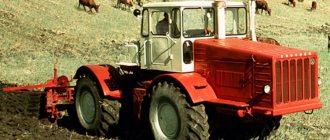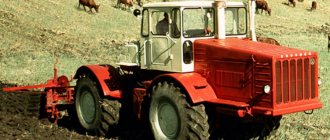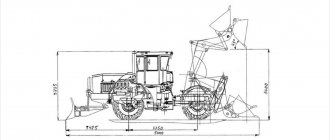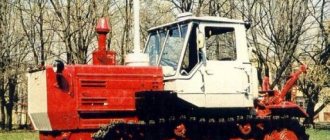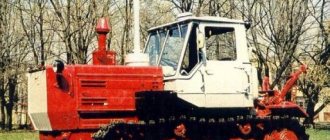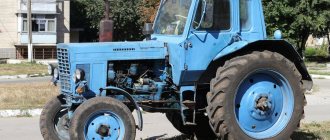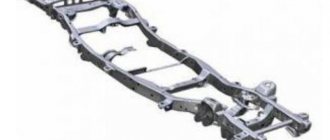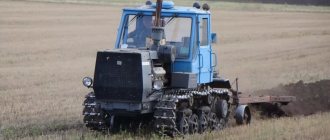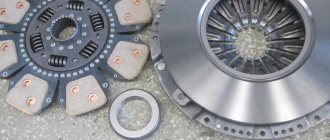By the 70s of the last century, it became obvious to progressive design engineers that the future lay in high-speed tractor units with increased power and the further evolution of tractor technology would go in this direction. Particular success in the development of this direction was made by the team of the Kharkov Tractor Plant named after Sergo Ordzhonikidze under the leadership of chief designer B.P. Kashuba.
In 1973, tractors of the T-150 type were accepted for mass production. A fundamentally new family of tractors was developed as a unified one, and the T-150 model existed in two modifications - tracked and wheeled. However, it was the wheeled model, the T-150K, that was especially popular. Its distinctive features: greater power, high productivity (2 times more compared to its predecessors), improved gearbox, and the ability to operate at high speeds (up to 15 km/h).
In total, the Kharkov Tractor Plant produced more than 753 thousand T-150K wheeled tractors and their modifications. The cars were successfully exported, raising the prestige of the country. In the USSR in the 70-80s of the last century, these powerful units became the first assistants in the countryside - they greatly improved working conditions and contributed to the rise of agriculture.
Predecessors
T-150K is not the first powerful wheeled tractor that was created at KhTZ.
Back in 1959, N. S. Khrushchev, after a trip to the USA, decided to “catch up and overtake” American farmers using wheeled tractors instead of tracked ones, and entrusted the development of a worthy competitor to the Kharkov tractor class=”aligncenter” width=”900″ height=”664 ″[/img] KhTZ Chief Engineer A. A. Soshnikov successfully completed this task. Under his leadership, a powerful wheeled tractor T-125 was created - a fundamentally new original model that has no analogues. It is believed that this tractor became the prototype of the T-150K. By the way, the T-125, like the T-150K, was a unified type vehicle, and it could be produced in a tracked version.
But still, we note that there was a fairly long gap between the release of the T-125 and T-150K models, during which the development of high-speed tracked tractors was carried out at the Kharkov plant. It was thanks to this experience that the T-150K was able to appear - the first powerful and high-speed wheeled tractor.
Power plus speed...
The development of high-speed tractors was undertaken by the chief designer of KhTZ B.P. Kashuba. In particular, he created an experimental series of high-speed tracked tractors DT-54M. Together with the All-Russian Research Institute of Agricultural Mechanization, laboratory and field studies were carried out at high speeds (5-9 km/h). The tests were successful, proving that the path of modernizing tractors towards speed is quite promising.
HTZ began producing a series of high-speed tractors almost like hot cakes! 1960 - the first high-speed tracked tractor T-75 in the USSR, 1962 - T-74. The operation of these machines has shown that it is possible to further increase operating speeds and it is quite possible to create even faster models.
Mechanical Upgrade
The most popular methods of modernizing the mechanics of the T-150 tractor can be divided into stages:
- Improve the box. Many people increase third gear.
- Strengthen the grip. To do this, change the clutch basket and disc.
- Equipped with a wheel doubling kit. It will provide better traction because the contact area will be larger
- Considering that the tractor already has a turbocharger, you can increase the power by replacing the engine.
- Install the intercooler. This is a system for additional cooling of the air entering the cylinders.
- Change the equipment settings, i.e. increase the fuel supply. Diesel consumption will increase, but engine life will decrease.
- Install a hydraulic pump of higher capacity. This will further increase the tractor's lifting capacity.
...plus wheels!
Finally, in 1967, Kashuba turned to the chief engineer of KhTZ V.V. A book with a proposal to develop at the plant a fundamentally new model of a powerful high-speed caterpillar tractor. However, the chief engineer set his own condition: that the new tractor be unified - have the possibility of both tracked and wheeled modifications.
This was a real challenge, because creating a unified unit is much more difficult than creating a tracked or wheeled unit separately. Nevertheless, the plant, the team and the chief designer coped with this task! As a result, tractors like the T-150 were born. In 1973, the State Commission approved their serial production, and in 1974 a Resolution was adopted on the creation of capacities for their production.
The wheeled model has gained great popularity. The wheels made it possible to use the tractor not only in the fields, but also for road work: the T-150K is adapted for movement on highways.
Tractor engine T-150K
Engine SMD-62, six-cylinder, four-stroke, turbocharged, diesel, 165 hp. (121.5 kW), with a crankshaft speed of 2100 rpm, was specially developed for the T-150K model. The engine cylinders are arranged in a V-shape with a camber angle of 90°. The cylinder bank houses the turbocharger and exhaust manifolds. Air is supplied to the cylinders by a turbocharger under excess pressure. Turbocharging increases the flow of air into the cylinders, which allows for increased power without increasing specific fuel consumption.
The fuel is injected by an injector into the combustion chamber, an open, toroidal, undivided type, located in the thick-walled piston crown. The toroidality of the piston ensures maximum air swirl. Direct injection of fuel into the combustion chamber (piston recess) makes it easier to start the engine and reduces specific fuel consumption.
The engine runs on diesel fuel. At air temperatures above 0 °C, use summer fuel, grades L or DL, at temperatures from 0 to -30 °C - winter fuel, grades 3 or DZ, at temperatures below -30 °C - arctic fuel, grades A or DA.
On the T-150K tractor, a two-stroke carburetor with crank-chamber purge starting engine P-350 with a power of 10 kW is installed on the flange of the diesel engine flywheel housing. The intake of the combustible mixture and the exhaust of exhaust gases is carried out through windows located in the engine cylinder, which are opened and closed by a piston.
Machine characteristics
Technical characteristics of the T-150 and basic information:
- Manufacturer : Kharkov Tractor Plant.
- Dimensions and weight. The special equipment weighs 8160 kg. The dimensions of the machine are 5000/1880/2680 cm (L/W/H).
- Lubrication system. The power unit is lubricated with diesel oil. The transmission uses nigrol gear oil and its analogues.
- Fuel. The tractor runs on diesel fuel.
- Engine. The vehicle has a six-cylinder V-shaped engine SMD-60. It is possible to install YaMZ 236 and YaMZ 238 engines.
- Starting the power unit. Engine start - double.
- Engine capacity – 11 liters.
- Fuel consumption is 230 g/l. With.
- Tank volume – 315 liters.
- Transmission. The T-150 has a manual transmission.
- Coolant. Both antifreeze and water can be used to cool an internal combustion engine.
- Engine speed. The nominal speed of the SMD-60 is 2100 rpm.
- Speed. The T-150 tractor in transport mode can reach speeds of up to 30 km per hour.
Other Features
The engine, together with the clutch and gearbox, is mounted on the tractor frame on four supports equipped with rubber-metal shock absorbers.
The T-150K has all driving wheels. The tractor is turned by the steering wheel using hydraulic cylinders acting on the articulated frame. Due to the “break” of the semi-frames in the horizontal plane, the tractor moves along a curved path.
The four-speed manual transmission, together with the clutch and engine, forms a common unit attached to the tractor frame on brackets and shock absorbers. The gearbox operates in several ranges (slow, working, transport and reverse), which are switched when the tractor stops. Gears are switched manually, without interrupting the power flow.
The T-150K has two brakes: central and wheel. The central handbrake is used for stopping in a parking lot. Wheeled is used to reduce the speed or completely stop a moving tractor.
Machine transmission
Gearbox of the T-150 tractor
The T-150 tractor has a manual gearbox with 12 forward gear positions. Thanks to the installed fluid couplings, gear changes can be made under load. The gearbox is equipped with a PTO gearbox, through which the torque from the machine transmission is transmitted to the attachments. The gearbox of the T-150 tractor is equipped with a special lock. It is impossible to start the engine with the gear engaged.
The machine has two driving axles. The front axle is the main one and works constantly. The rear axle can be disabled if necessary.
Tracked vehicles are equipped with a dual-flow gearbox. This means that gears can be individually selected for each track. Installation of a dual-flow box is necessary in order to operate the machine. The steering of the car, regardless of modification, is carried out using the steering wheel.
Cabin of the T-150K tractor
The cabin of the T-150K tractor is a special pride of the designers! Never before has it been so comfortable and convenient. The tractor driver in it could feel like a real king.
The spacious (for two seats) all-metal sound- and dust-insulated sealed cabin is equipped with a ventilation and heating system, equipped with a sun visor, a first aid kit, rear-view mirrors and glass cleaners. There are even hooks for clothes and a thermos for drinking water! The driver's seat is sprung and adjustable depending on the weight and height of the driver.
Tractors without an air cooler have front side windows that open on hinges.
The right and left doors are hung on special hinges connected to the frame.
Between the panels there is a frame with glass and a window lift mechanism. A window handle, a lock, an opening limiter, and a handrail are attached to the inside of the door.
The door glass, as necessary, can be raised up until it enters the seal, lowered down, or fixed in any intermediate position using the window lifter handle lock.
It is not recommended to lower the window when working with the air cooler turned on.
At the rear of the cabin there is a fuel tank mounted on rubber gaskets, which is pressed at the bottom with a wedge bed and at the top is pulled motionless to the cabin by two steel belts.
The cabin, together with the fuel tank, is mounted on four rubber supports.
After installing the cab and tightening the bolts of the front and rear supports, there should be a gap of up to 1 mm between the buffer and the conical hole of the bushing.
Seats. In the tractor cabin, it is possible to install both two sprung seats, one sprung and the other rigid. The tractor, which is not equipped with an air cooler, has two seats, adjustable according to the height and weight of the driver, sprung, with a parallelogram suspension and a hydraulic shock absorber. On a tractor with an air cooler, the passenger seat is hard; underneath there is a water tank (the possibility of a second sprung seat is provided).
Soft cushions and seat backs are laid on a stamped panel (Fig. 183). On tractor seats of later production, the backrest cup is separated and, thanks to rearrangement along special cutouts, can be installed at a different angle.
Rice. 1. Cabin:.
The design of the seat allows you to adjust its position according to the driver’s weight and height (height and length of the cushions). The adjustment is made as follows.
1. By driver weight (from 60 to 120 kg) - by rotating the adjusting screw.
On the side surface of the four-link fork there are marks indicating the position of the rear washer corresponding to the driver’s weight.
After adjustment, it is necessary to unscrew the screw slightly so that the corners of the rear washer do not rest against the fork, otherwise a squeaking noise may occur when moving.
2. In height (±40 mm) - by rotating the threaded bushing 2 located under the screw head. When screwing
When the bushing is removed, the seat height in the static position decreases; when the bushing is unscrewed, the seat height increases.
3. The length (±75 mm) of the seat is adjusted as follows: the wing nuts securing the panel are released on both sides, the panel is moved forward or backward along the guides 4 to the required distance and the wing nuts are tightened again. When installing the seat in the rear position, the gap from the cabin wall must be at least 15 mm (along the upper edge of the backrest). The tilt of the seat back is adjustable regardless of its length position.
4. The dynamic stroke (±60 mm) is adjusted when assembling the seat by installing a special washer at a distance of 108±1 mm from the end of the screw, which is a limiter of the dynamic downward stroke of the seat. With all adjustments, the dynamic movement of the seat is maintained. All adjustments are made on a free seat.
The panel and the base of the seat are connected by a hydraulic shock absorber, which dampens low-frequency vibrations when the seat enters the swing resonance. At the bottom, the shock absorber is mounted on two elastic rubber wedge inserts. At the top, the shock absorber rod rests on a curly bracket, hinged on axles installed in the hole of the upper link of the parallelogram.
Rice. 2. Lock: 1 - lock body; 2—lock cover; 3 - rod; 4 — rod strip; 5 — tension spring; 6—inner lock handle; 7 - cam; 8—outer handle; 9 — locking bracket; 10 — rod spring; 11—spring cotter pin; 12 — inner handle spring..
Rice. 3. Window lifter: 1 - roller; 2 - chain; 3 — door glass bracket; 4 — door glass; 5 — clamp spring; 6 — window lifter handle; 7 — clamp; 8 — tension roller bracket; 9 - asterisk..
US-4451007 double-acting consists of a reservoir and a cylinder located concentrically in it, filled with shock-absorbing fluid, along which a piston mounted on a rod moves.
In some cases, for example, when the tractor is plowing across the furrows, it is advisable to lock the four-link hinge of the seat by fully tightening the spring until it stops. On the latest edition seats, a movable bracket is installed for this purpose, mounted on the lower bracket, which can be engaged with a pin on the upper support and tightened with a wing nut.
Rice. 4. Driver's seat: 1 - adjusting screw; 2— bushing; 3 — wing nut; 4 - guide; 5—panel; 6—spring; 7 - special washer; 8 — rubber stop..
Rice. 5. Cabin ventilation: 1 - hood; 2—guide pipe; 3 — shield; 4 — adjusting washer; 5 — adjusting gasket; A is the distance between the edge of the impeller belt and the end of the fan housing partition; B—gap between the upper hatch of the impeller and the fan housing..
Cabin ventilation. On tractors without an air cooler, ventilation is provided both through the door windows and through opening front (side) windows. The door glass and front window frame can be fixed in any intermediate position.
In addition to natural ventilation, there is supply ventilation from a dust separator fan installed on the roof of the cabin.
The air taken by the fan from the atmosphere through an opening under the hood is subjected to centrifugal dust cleaning and is supplied to the cabin through a special pipe. Dust is ejected through an outlet located on the lower fan housing.
The direction of the air flow supplied to the cabin is regulated by a flap located under the cabin roof.
The fan switch is installed on the instrument panel.
Cabin heating. The cabin is heated with warm air from a water radiator supplied by the engine fan through an intake along a metal hose.
When entering the cabin, warm air is directed through pipes with slots to blow on the windshields and into the cabin through the outlet pipe. Window blower pipes are located along the lower edges of the front windows, and the outlet pipe is located under the instrument panel.
At the outlet pipe under the instrument panel there is a damper with a handle, by turning which you can direct all the incoming warm air to blow off the windows.
Using a flap in the inlet pipe under the hood, you can completely shut off the supply of warm air into the cabin. When open, the damper handle is located along the axis of the pipe; when closed, it is located across it.
With the help of a blower installed in the cabin, you can change the direction of the flow of warm air, directing the stream to blow on the rear windows of the cabin.
The recommended temperature in the cabin in winter is 5-10 °C.
In the summer, in order to avoid additional heat inflows, it is necessary to remove the intake with a metal sleeve and a cover from the tractor.
t close the inlet hole with a flap installed on the branch pipe of the front wall of the cab on the hood side.
Cabin equipment. To improve the work of the tractor driver, the cabin is equipped with additional devices.
In addition to pneumatically driven front windshield wipers, a mechanical rear window wiper is installed.
The rear window is fenced with a protective armored mesh, which creates operational safety during loading and unloading operations, etc. A mirror is installed on the lintel of the front window inside the cabin.
When performing transport work, the mirror can be moved outside and mounted on a special holder on the left side of the cabin.
A sun visor is hinged above the left front window and can be adjusted to any convenient position. At the entrance to the cabin, a three-liter thermos for drinking water is secured with spring brackets.
In the left rear corner of the cabin, near the back of the seat, there is a case for a first aid kit.
The cabin floor is covered with rubber mats. The cabin is equipped with: a tool box and a spare parts box for electrical equipment; a place for a fire extinguisher and a place for a blower.
The casing and hood protect the engine and main mechanisms of the tractor from dust, water and dirt. For ease of maintenance of the engine and other units located in the engine compartment, quick-release front radiator guard nets and mudguard extensions, hinged opening sides and a hatch for filling water into the radiator, etc. are used.
Directly in front of the cabin there is a hood frame on which flaps are attached that block the flow of hot air and its access to the front wall of the cabin.
Side mudguards are placed on the radiator guard and hood frame.
The rear and front wheels of the tractor are covered with wings at the top and rear. The front wings are attached along the contour of the lower front bevel of the cabin; rear - on reinforcements to the rear section of the frame. Tool boxes are adjacent to them on the inside of the rear wings; to the front fenders - running boards.
The hood roof is superimposed on the radiator guard (on rubber stops), resting on the frame at the rear.
World Star
The T-150K truly turned out to be a tractor of a fundamentally new class, not only in its powerful technical parameters, but also in design and level of comfort for the driver. Sealed comfortable cabins, a sprung tractor driver's seat, light and comfortable steering, transmissions with gear shifting on the fly, stable heavy-duty tires - all this was noted not only by domestic but also foreign experts, and the T-150K successfully entered the world market.
From 1973 to 1977, the tractor received five gold awards at international exhibitions! In 1979, during tests in the USA (International Tractor Test Site, Nebraska), the T-150K developed a thrust that was almost equal to its weight, and the Americans immediately dubbed it a tractor that can lift itself.
In 1980, the creator of the revolutionary unit, the Kharkov Tractor Plant, received the international Golden Mercury award for peace and cooperation. Thanks to the worldwide recognition of the T-150K, KhTZ has significantly increased its exports. From 1976 to 1990, 21,863 such models were delivered to the USA, Canada, Australia, Europe, Asia and Africa.
Modifications
There are three main types of this tractor. The T-150KS1 is equipped with a hydraulic attachment system, an independent power take-off shaft, a trailing shackle and a harness, a PZHB-300 preheater, a hydraulic hook, an evaporative air cooler and a breakaway coupling with hoses.
The T-150KS2 is equipped in the same way as the T-150KS1, but without the rear linkage, power cylinder with hoses, PTO, hydraulic hook and pre-heater.
T-150KSZ is a tractor with a hydraulic traction hook. It is equipped in the same way as the T-150KS1, but without a towing bracket and harness, PTO and pre-heater (a breakaway coupling with hoses is included with the tractor).
Numerous modifications were created on the basis of the T-150 family of tractors: the T-156 loader, the T-150D and T-150DK bulldozers, the T-155 military engineering tractor, the T-158 and T-157 industrial and forestry tractors, the ESVM-7 chemical treatment machine and etc.
Subscribe to our Telegram channel
Tractor power unit
Fuel pump for SMD-60 engine
The T-150 is equipped with a six-cylinder diesel engine SMD-60. On newer car models, the manufacturer installs a power plant from the Yaroslavl Motor Plant. A tractor with an SMD-60 engine has a power of 165 horsepower. This is quite enough to perform various types of work.
The launch of the T-150 power plant is carried out in two stages. First, the auxiliary single-cylinder gasoline engine is driven by an electric starter. Then, using the auxiliary motor, the main unit is started.
The YaMZ-236 unit is started up somewhat differently. This power plant does not have an auxiliary engine. In this regard, the start is made by an electric starter, the supply voltage of which is 24 V. For normal engine starting in winter, the machine is equipped with a pre-heater.
Help: the heater is used if the ambient temperature is below -5 degrees.
